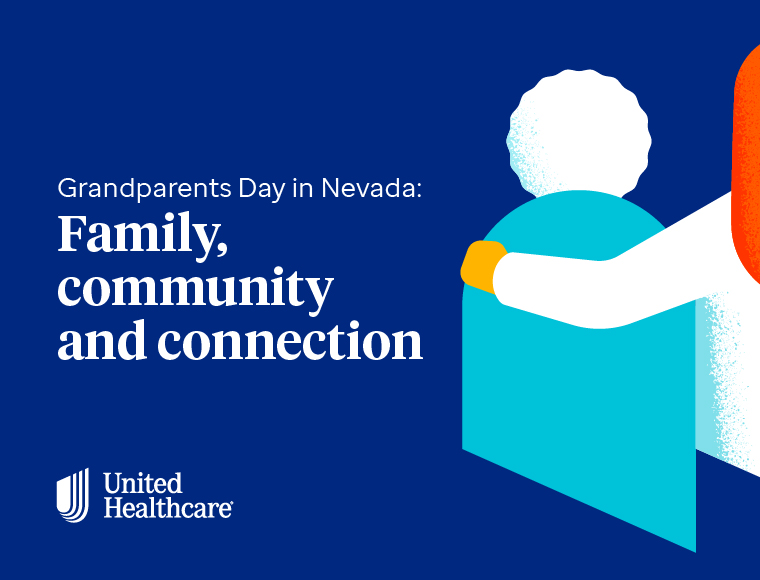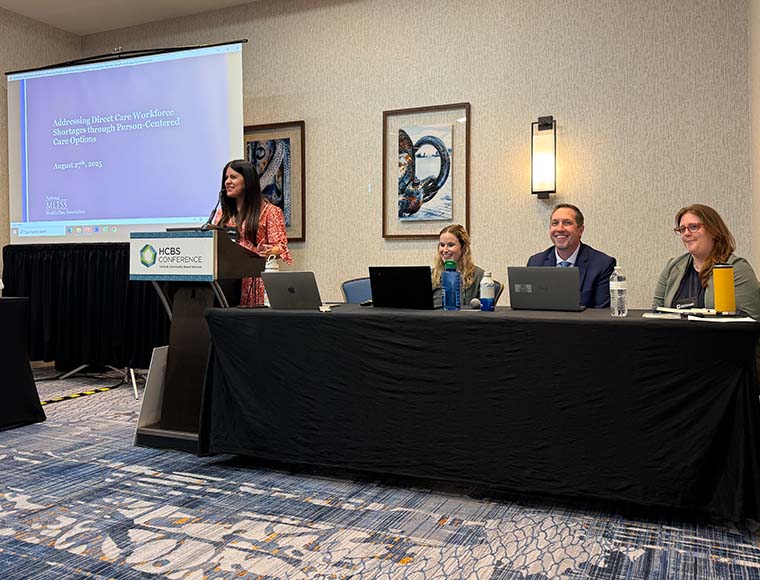To date, there has been little consensus from the federal government and state Medicaid agencies around which quality measures are most appropriate for monitoring the care delivered to complex subpopulations such as individuals of advanced age or those with a disability who use long-term services and supports (LTSS). Work related to measuring the quality of LTSS services provided has been slow to develop and expand. This is partially due to the delivery system typically used for these services as well as the unique functional and health care needs of this population, which require highly individualized treatment and interaction.
As more states begin to transition LTSS consumers into Medicaid managed care, it is imperative that the federal government, states, stakeholders, beneficiaries, and insurers work together to determine which measures are most appropriate for the population.
As a first step, UnitedHealthcare Community & State has defined a proposed quality framework that highlights a small subset of key elements that are important to more meaningfully measure the quality of LTSS provided to individuals of advanced age and/or those with a disability.
It is critical that the primary goals of any quality framework focused on LTSS are to both serve the members and reduce their burden of participating in data collection. The key measurements that are highlighted in this paper were selected through a lens focused on the needs of this vulnerable population.
Unique characteristics and needs of individuals accessing LTSS
Long-term services and supports are not health care services; rather they are a range of services coordinated across many providers and settings to address the needs to individuals who have functional limitations that impair their ability to carry out activities of daily living (ADL). These services and supports may include, but are not limited to:
- Custodial nurse care
- Attendant, home care, companion, and personal care services
- Assisted living
- Adult day care
- Transition programs
- Home modifications
- Durable medical equipment and supplies, such as wheelchair ramps and shower grabs
- Routine transportation
LTSS is delivered in institutions, such as nursing and intermediate care facilities, as well as home and community- based settings, such as individual apartments, family homes, or group homes. Over the last 20 years, an increasing number of individuals are served in home and community-based settings due to the choices of individuals with disabilities and, in part, to states’ obligations under the Supreme Court’s Olmstead decision, which found that the unjustified institutionalization of persons with disabilities violates provisions of the Americans with Disabilities Act (ADA).
States are responding to numerous pressures related to individuals in need of LTSS. In addition to fulfilling the subsequent requirements of the Olmstead decision, states are faced with increased desire by consumers and federal regulators to expand community-based options for those in need of LTSS. Additionally, the economic pressures of serving a more aged and complex population have created cost trends that are not sustainable. Due to these pressures, states have increasingly turned to managed care or managed long-term services and supports (MLTSS) to control costs and improve outcomes for these complex consumers.
Individuals receiving LTSS constitute several overlapping populations and Medicaid eligibility categories, each requiring varying levels of care. Frequently, these individuals experience different challenges and require coordination with different agencies, providers and community-based organizations. While the needs of these individuals are highly individualized and the population, in general, can be highly complex, trends based upon functional needs assessments will allow persons of different diagnoses to be considered together, based upon common functional needs.
- Individuals of all ages – elderly and non-elderly – with intellectual and developmental disabilities, physical disabilities, behavioral health diagnoses (e.g., dementia), spinal cord or traumatic brain injuries, or disabling chronic conditions require LTSS.
- Medicaid is the largest single payer of LTSS, covering 62 percent of all LTSS spending.1 Nearly 10 million individuals are enrolled in both Medicaid and Medicare (MMEs). LTSS accounts for approximately 60 percent of all Medicaid spending for this group.2
- Elderly adults with disabilities are the primary beneficiaries of LTSS and are costly to the entire Medicaid program. They are part of a larger eligibility category commonly referred to as aged, blind, and disabled (ABD). While not all of the ABD population is in need of LTSS, they have an increased risk of becoming dependent and are the most expensive population served by Medicaid. This eligibility group comprises less than one-third of Medicaid beneficiaries, but two-thirds of Medicaid spending.3
- Only a small portion of beneficiaries – approximately 1.5 percent – is currently enrolled in an MLTSS program.4
- Approximately 25 percent of individuals enrolled in MLTSS require institutional-level care.5 However, many of these individuals choose to remain in their own homes with appropriate services and supports.
- The number of individuals requiring LTSS is expected to increase in the coming decades. The number of elderly Americans is projected to double in the next 40 years as life expectancy remains high and the “baby boomer” generation continues to age.6
- Approximately 70 percent of individuals age 65 and over are projected to require LTSS. The fastest growing population, those age 85 and older, are four times more likely to need LTSS than those ages 65 to 84.7
In the United States, the majority of LTSS is provided by unpaid caregivers, typically relatives and friends, in home and community-based settings, allowing many with LTSS needs to age in place. Informal – largely uncompensated – caregivers provided approximately $470 billion in care in 2013.13 This unpaid care ranges from help with getting to doctor appointments or paying bills to more intensive care such as assisting with bathing or wound care. As a person’s daily care needs become more extensive, they often require paid LTSS delivered by direct care workers, such as medical professionals. The number of informal caregivers is expected to decline, increasing the importance of paid LTSS services delivered by medical professionals and paraprofessionals and managed by Medicaid health plans.14
All of the unique health needs and service utilization characteristics are important differentiators from other populations and should be considered when developing effective and appropriate ways to monitor the quality of care received and quality of life.
Providing LTSS in a managed care setting
While historically the majority of LTSS services have been delivered through fee-for-service (FFS) Medicaid, the number of states choosing to deliver LTSS through managed care organizations has increased in recent years. By the end of 2015, 26 states had implemented an MLTSS program, more than tripling the number of states that delivered LTSS on a capitated basis just 10 years prior.15 The introduction of managed care allows for consistent opportunities for data collection and analysis as compared to the non-managed FFS delivery system. Medicaid managed care provides an environment for the rigorous collection of quality data that simply cannot be achieved in the FFS environment due to the lack of comparable federal and state FFS requirements.
States can implement MLTSS using an array of managed care authorities, including 1915(a), 1915(b) waivers and section 1115 demonstrations. Any of those managed care authorities can be ‘paired’ with state plan home and community-based services (HCBS) or an HCBS waiver under 1915(c). Additionally, section 1115 demonstrations can be used alone to authorize the managed care delivery system as well as the HCBS benefits offered through that delivery system, when these reforms are part of a larger demonstration project.16 The 1915(c) waiver program is the single largest payment source for LTSS in the United States.17
UnitedHealthcare Community & States has participated in MLTSS programs beginning in 1989 and now currently supports LTSS benefits in Arizona, Delaware, Florida, Hawaii, Kansas, Massachusetts, New Jersey, New Mexico, New York, Ohio, Tennessee, and Texas. In addition, as of March 1, 2016, we implemented the full set of Medicaid state plan and waiver benefits in Iowa.
Current national managed care quality measurement systems, such as HEDIS and CAHPS, are not sensitive enough to the complex needs of individuals of advanced age or with disabilities. While the federal government has endorsed a core set of HCBS quality metrics, they are not required for states. A separate core set of measures has been defined for MMEs participating in the Financial Alignment Demonstration to more closely integrate care for beneficiaries navigating between these two programs; however, these measures are more focused on acute care as opposed to LTSS.
CMS has issued guidance to states on 10 essential principles for developing MLTSS programs focused on effectiveness and improving outcomes, including requirements for quality management.
Going forward, states implementing MLTSS programs are expected to include a comprehensive quality strategy for assessing and improving care and quality of life for LTSS beneficiaries that aligns with existing Medicaid quality initiatives and systems leveraging this framework.18 While these elements provide a stronger framework for states in designing effective MLTSS programs, they do not provide measurable metrics with which to determine quality of care.
Due to the lack of a consistent national approach, states have embarked on developing their own measures for the provision of MLTSS, leading to widely differing approaches, primarily focused on processes as opposed to outcomes. There are inherent challenges with adapting quality measures for this population beyond the lack of consensus on core measures, including:
- Current quality measures widely used with other Medicaid populations do not easily translate and address the full spectrum of needs for individuals with complex conditions accessing LTSS, particularly for services that support activities of daily living.
- Current Medicaid quality measures, for the most part, are focused on structure and process and are not more widely focused on individual outcomes and personal experiences, which are the basis of more specialized services such as LTSS.
- Quality of life and individual experience perspectives are difficult to quantify consistently given the need to gather data through interviews, surveys, etc., and the subjectivity involved with topics such as quality of life.
- Goals, outcomes of care, and supportive services are personalized and can mean different things to individuals with complex conditions, which makes the use of standardized metrics and tools challenging.
- Depending on the state and Medicaid program, HCBS services may be covered under different arrangements through either FFS, primary care case management (PCCM), or managed care. This makes data collection difficult since federal government data-collection requirements for managed care organizations (MCOs) are more robust than those for FFS. Data-collection requirements can also be enforced through MCO contracts, whereas there is less recourse for collecting quality data from providers in Medicaid FFS and PCCM.
- There are also varying degrees of coverage under Medicaid for HCBS and not all states cover the same types of services across the various populations accessing services. Beyond traditional Medicaid services, there is not a defined set of core benefits that must be provided to individuals with complex conditions to ensure coverage of key support services.
As more states consider transitioning delivery of LTSS to managed care from FFS, there are key policy and service delivery issues that must be addressed to ensure that individuals have the most appropriate access to care in these types of settings. While MCOs must adhere to Olmstead and ADA requirements to ensure that all individuals receive services in accessible community integrated settings, it is also important that individuals have adequate access to MLTSS and HCBS services that aim to preserve existing provider relationships established by beneficiaries before they transition to managed care. There has been increased activity by advocates, stakeholders, and industry groups over the last several years to outline how individuals can best receive the most appropriate access to care in these types of settings.
To monitor the appropriateness of care delivery and access to services, it is essential that appropriate quality metrics that promote person-centered care and decision-making in the provision of LTSS are defined and implemented.
Overview of current data collection methodologies
Despite the challenges noted above, there has been work to date to determine the most appropriate measures for gauging the quality of MLTSS services delivered in both institutional and community settings. While some of these tools are specifically geared toward subsets of the LTSS population, some of them may have broad applicability with advancing quality of care discussions for the provision of these services.
- The National Quality Forum (NQF), with funding from the Department of Health and Human Services, is performing an environmental scan for HCBS measures and measure concepts, identifying gaps in HCBS measures, and ultimately making recommendations to CMS for HCBS measure development. The two-year project, which is inclusive of all payers, settings, and services, is expected to conclude in late 2016. The working group convened by NQF released an initial, conceptual framework in July 2015 that includes the following domains:19
- Workforce
- Consumer voice
- Choice and control
- Human and legal rights
- System performance
- Community inclusion
- Caregiver support
- Effectiveness and quality of care
- Service delivery
- Equity
- Health and wellness
- In a related effort, NQF established a workgroup several years ago focused on defining a core set of measures for monitoring the quality of care delivered to MMEs. While not exclusively focused on long-term services and supports, several of these measures apply to the delivery of HCBS. The workgroup’s final recommendations, concluded in 2015, included a defined group of core metrics that support quality of care monitoring for HCBS. CMS has not yet formally endorsed these metrics.
- CMS is working to test an HCBS Experience of Care Survey for Medicaid programs. The survey will ultimately receive CAHPS certification. It is geared toward state FFS and MLTSS programs that serve individuals who are frail and elderly, adults with disabilities, and individuals with ID/DD. It aims to gauge individuals’ experiences (not satisfaction) with HCBS and can be administered using a combination of phone or face-to-face interviews. Tennessee is currently participating in testing the new survey.20
- The Long-Term Quality Alliance (LTQA) identified measurement gaps for LTSS beneficiaries that also suggested areas for measure development and/or research. These include transitional care measures for person- and family-centeredness. Specifically, measures were identified that contribute to overall quality for individuals and their families and that are broader than clinical outcomes (i.e., quality of life, autonomy, relationships, compassion, social supports, and emotional well-being).21
- The Council on Quality and Leadership (CQL) created a set of Personal Outcome Measures (POMs) in 1991. These measures have been refined over time to capture individual quality of life outcomes and emphasize choice and self-determination. Measures are specifically geared toward individuals with disabilities and individuals with mental illness. The three key domains of the POMs are: My Self, My World, and My Dreams. Some states, such as New York, are beginning to incorporate the three domains with 21 specific POMs into their work with individuals with disabilities to ensure that services are meeting key quality of life desires and outcomes of the population.
- The National Core Indicators-Aging and Disabilities (NCI-AD) is a promising tool. NCI-AD is an initiative designed to support states’ interest in assessing the performance of their programs and delivery systems in order to improve services for older adults and individuals with physical disabilities. NCI-AD is a collaborative effort between the National Association of States United for Aging and Disabilities (NASUAD) and the Human Services Research Institute (HSRI). NCI-AD’s primary aim is to collect and maintain valid and reliable data that give states a broad view of how publicly-funded services impact the quality of life and outcomes of service recipients.
- The State of Wisconsin uses a state-specific interview/ survey tool called PEONIES. It is used to compare the quality of life experiences of people served by various state long-term care programs and across different target population groups. Survey data provides information on outcomes most important to individuals, the status of outcomes with regard to achievement and support, and the types and sources of supports that are needed.
PEONIES identifies outcomes in 12 distinct quality of life domains; however, not all areas are equally important because members may not identify outcomes in all 12 areas.
- I decide where and with whom I live.
- I make decisions regarding my supports and services.
- I decide how I spend my day.
- I have relationships with family and friends I care about.
- I do things that are important to me.
- I am involved in my community.
- My life is stable.
- I am respected and treated fairly.
- I have privacy.
- I have the best possible health.
- I feel safe.
- I am free from abuse and neglect.
- Healthy People 2020 is a science-based initiative led by the U.S. Department of Health and Human Services with the goal of improving health for all Americans.22 Healthy People 2020 identifies the following priorities for action to address LTSS:
- Reduce the proportion of noninstitutionalized older adults with disabilities who have an unmet need for LTSS
- Reduce the proportion of unpaid caregivers ofolder adults who report an unmet need for caregiver support services
- Reduce the rate of pressure ulcer-related hospitalizations among older adults
- Reduce the rate of emergency department (ED) visits due to falls among older adults
- Increase the number of States, including the District of Columbia, and Tribes that collect and make publicly available information on the characteristics of victims, perpetrators, and cases of elder abuse, neglect, and exploitation.
- The Patient-Centered Outcomes Research Institute (PCORI) has noted “improving the care continuum for individuals with disabilities” as a research priority.23 PCORI is placing a specific focus on the effectiveness of interventions to improve the continuum of care for community dwelling for nonelderly adults with disabilities; interventions include access to care, care coordination, and quality of care. The independent living community will closely follow this initiative.
- The Agency for Healthcare Research and Quality (AHRQ) notes disability as a priority population for improving health disparities through improved cultural competency.24 The agency’s research focuses on both children and adults with disabilities and considers provider attitudes and training, patient intermediate outcomes (such as access barriers and perceptions of care), final health outcomes, patient-centered health outcomes (with a particular focus on mental health, substance abuse, preventive care use and medical outcomes), and negative consequences or unintended consequence of interventions.
- The University of California, San Francisco Center for Personal Assistance Services created a set of Selected Inventory of Quality-of-Life Measures for LTSS Participant Experience Surveys. The measures in the surveys focus on community integration for HCBS. Examples of measures include the consumer’s satisfaction with their own community involvement, control over leisure activities, and choice in living arrangement.
Challenges and considerations in selecting measures
The needs of the aged and disabled populations can be viewed on a continuum, much like health. This brings about challenges ensuring that quality measures and initiatives uphold a person- centered approach that considers individual needs and goals while understanding that generalities are necessary to facilitate a population-specific quality program.
Assistant Secretary Kathy Greenlee, Administration on Community Living, has noted that the complexity in determining the appropriate quality measures should arise from the values deemed important by the individuals served. However, individuals and interested parties (e.g., advocacy groups) may advance competing initiatives and various value statements, making consensus difficult. Other challenges include the following:
- Monitoring and regulatory requirements in various states and settings impact the development of quality measures that address quality of life versus traditional provider performance (e.g., group home regulations). Policy and advocacy stakeholders note the need for a shift to quality-of- life driven quality programs MLTSS.
- Numerous factors (e.g., age, disorder/diagnosis, co-morbid/ co-occurring conditions, placement or setting, and gender) impact the specific quality measures appropriate for sub- populations within the broad LTSS-recipient population and increase the complexity of determining and tracking the appropriate grouping or denominator for each measure.
Core quality elements and recommendations
As an organization, UnitedHealthcare Community & State engaged the expertise of a National Advisory Board (NAB) to assist in the understanding of the special needs of the aged and disabled populations and to determine appropriate measures to assess the quality and effectiveness of care. The NAB serves as an independent advisory council that provides input to UnitedHealthcare in actively engaging members, providers, advocacy groups, and other key stakeholders in the design and delivery system supporting individuals with special health care needs. The NAB makes recommendations, develops and champions innovations and advises on member engagement strategies that support clinical approaches. NAB comprises leading experts and aging and disability advocates as well as a Community & State health plan member, a direct care worker, and family member of a child with special health care needs.
In 2015, NAB initiated a yearlong project to identify the subset of the most critical measures for any state monitoring the quality of managed long-term services and supports. The board surveyed the landscape of leading MLTSS quality measurement tools and recommended frameworks, including the NCI, state-specific measures, and federal regulations.
It was crucial to UnitedHealthcare Community & State that the key measures ultimately identified represent the most meaningful and impactful areas for the aging and disabled population in terms of services sought, services used, and overall quality of life.
The result of the board’s efforts is a list of quality measures that apply to the complex needs of MLTSS beneficiaries in both institutional and community settings, focus on outcomes, and are immediately actionable in any state MLTSS program. UnitedHealthcare Community & State endorses these measures as a part of a strong quality framework for any state implementing MLTSS in its Medicaid program. The National Association of States United for Aging and Disabilities, the National Council on Aging, and Leading Age, among other recognized national leaders in aging and disability have endorsed our quality measurement framework
Measures are segmented into key domains and include the existing source from which the information can be obtained:
- Access
- Health Status/Medical Care
- Living Independently/Choice and Decision-Making
- Service/Care Coordination
- Community Integration
A call to action for states, advocates, and consumers
This paper has laid out the challenges that states and health plans face in implementing a strong, consistent quality framework for MLTSS. As noted above, due to these challenges, there is currently no consistent, national approach for quality measurement for MLTSS.
As a result, frameworks used across states are inconsistent and disjointed, making it challenging to measure quality across state lines and to identify opportunities for programmatic or delivery improvement to ultimately improve outcomes for aged and disabled populations. Additionally, because the metrics and frameworks deployed often evolve from procurement to procurement, measuring quality longitudinally is also a challenge.
As more states move toward managing the LTSS benefits within Medicaid managed care arrangements, it has become crucial that states begin to measure quality consistently across their programs. We are encouraging states to adopt a nationally endorsed baseline framework of quality metrics for LTSS. Of critical importance is ensuring that the metrics states adopt focus on outcomes and include measures that states, health plans, and stakeholders can track to identify areas to improve quality of care and experience. The measures recommended by the NAB and endorsed by UnitedHealthcare Community & State provide an expertly vetted, person- centered, outcomes-focused, comprehensive baseline for a quality framework that can be used by all states administering an MLTSS program.
By implementing this MLTSS quality framework, Medicaid programs are better positioned to:
- Measure progress on outcomes that matter most to individuals served in LTSS programs
- Ground policy and program design decisions in data
- Compare the state’s program to other states and national trends
If multiple states implement the same baseline framework and measures, nationally all stakeholders will experience a greater understanding of the impacts of delivery system and benefit design considerations and their impacts on outcomes.
States interested in progressing toward advance accountability, evidence-based decision-making, and quality should consider taking the following steps:
- Review the framework and determine what if any steps need to be made to implement the quality framework.
- Share with stakeholders the rationale for a consistent quality framework.
- Seek participation from and work with the local provider, health plan, consumer, and advocacy communities to evaluate any state-specific measures that the state should track in addition to (not in lieu of) the baseline framework.
- In upcoming requests for proposals, require that bidding health plans leverage a specific set of universal quality measures as a condition for being selected as the MLTSS plan.
Advocates
Organizations and individuals advocating for quality, person- centered care for individuals receiving MLTSS services are critical partners in advancing progress toward consistent, outcomes-focused quality measurement. Advocates invested in this effort should consider taking the following steps:
- Leverage your organization’s platforms to publicize the challenges caused by inconsistent quality measurement and endorse this quality framework as the first step toward consistency and accountability in decision-making for MLTSS programs.
- Launch letter-writing campaigns, author op-eds, and conduct other outreach to state and federal officials to encourage adoption of a consistent quality framework across states.
- Encourage partner organizations to join the effort to advance the quality framework.
- Work with the local provider, health plan, and consumer communities to evaluate any state-specific measures that a specific state should track in addition to (not in lieu of) the baseline framework.
Consumers
Individuals receiving LTSS services, as well as their family members and caregivers, are vital to the advancement of a consistent quality framework for MLTSS programs across states. Lending your voices to this effort provides policymakers with the understanding of how an outcomes-based, person- centered quality framework directly impacts the quality of care provided to MLTSS recipients. Consumers interested in advancing this effort should consider the following steps:
- Reach out to state officials, through letters or calls to state offices, outlining the challenges posed to MLTSS recipients and the critical need for a consistent framework to improve quality of care provided within MLTSS services.
- Actively participate in public meetings regarding LTSS or Medicaid, advancing the call to state leaders to adopt the consistent quality framework.
- Encourage members of your community to join the effort to advance the quality framework.
- Select an advocacy organization in which to join and become an active participant.
Sources
- MACPAC Report to Congress on Medicaid and CHIP. March 2012.
- Medicaid and Long-Term Services and Supports: A Primer, Kaiser Family Foundation.
- Congressional Budget Office. Dual-Eligible Beneficiaries of Medicare and Medicaid: Characteristics, Health Care Spending, and Evolving Policies. June 2013.
- State Healthcare Facts. Kaiser Family Foundation.
- Centers for Medicare and Medicaid Services (CMS). The Growth of Medicaid Long Term Services and Supports.
- Medicaid and Long-Term Services and Supports: A Primer, Kaiser Family Foundation.
- Medicaid and Long-Term Services and Supports: A Primer, Kaiser Family Foundation.
- Medicaid and Long-Term Services and Supports: A Primer, Kaiser Family Foundation.
- Medicaid and Long-Term Services and Supports: A Primer, Kaiser Family Foundation.
- Genworth 2015 Cost of Care Survey.
- Genworth 2015 Cost of Care Survey.
- MACPAC Report to Congress on Medicaid and CHIP. March 2012.
- Reinhard, et. al. Valuing the Invaluable 2015 Update: Undeniable Progress, but Big Gaps Remain. AARP Public Policy Institute.
- Medicaid and Long-Term Services and Supports: A Primer Kaiser Family Foundation.
- MACPAC analysis of Saucier et al. The growth of managed long-term services and supports (MLTSS) programs: A 2012 update and NASUAD, State Medicaid Integration Tracker October 2014.
- CMS. Guidance to States using 1115 Demonstrations or 1915(b) Waivers for Managed Long Term Services and Supports Programs. May 2013.
- Ibid.
- Ibid.
- National Quality Forum. Home and Community Based Services Quality Project.
- Office of the Assistant Secretary for Planning and Evaluation. Quality in Managed Long Term Services and Supports Programs. November 2013.
- Young, et al., “Measurement Opportunities and Gaps: Transitional Care Processes and Outcomes Among Adult Recipients of Long-Term Services and Supports,” prepared for Long-Term Quality Alliance (LTQA), December 2011.
- Healthy People 2020: Overview
- Patient-Centered Outcomes Research Initiatives: Research Priorities.
- Agency for Healthcare Quality and Research: Improving Cultural Competency to Reduce Health Disparities in Priority Populations. Jul 8 2014.











